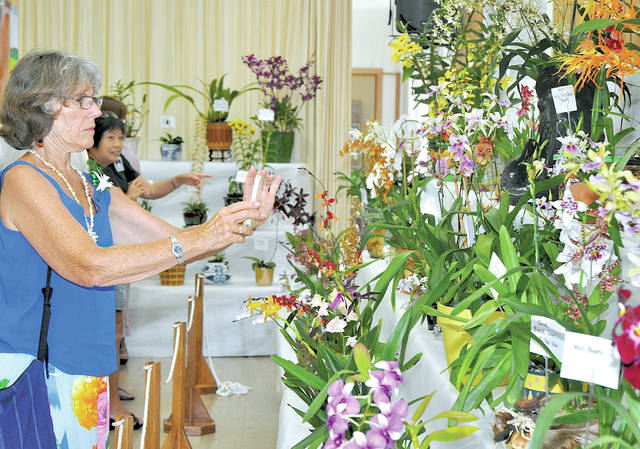Tropical Gardening: Don’t miss the 36th annual Kona Daifukuji Orchid Show and Sale

Photo courtesy of FERN GAVELEK A woman takes a photo of orchids on display during a previous Kona Daifukuji Orchid Show and Sale. This year’s show and sale are slated for Sunday, Aug. 12.
If you want to try growing orchids and rub elbows with the experts, be sure to check out the annual Kona Daifukuji Orchid Show and Sale from 8 a.m.-2 p.m. this coming Sunday, Aug. 12.
If you want to try growing orchids and rub elbows with the experts, be sure to check out the annual Kona Daifukuji Orchid Show and Sale from 8 a.m.-2 p.m. this coming Sunday, Aug. 12.
This year’s theme is “Conservation of Orchids Through Creativity.” There will be an orchid gami exhibit by Carol Zakahi in collaboration with the North America Conservation Center and United States Botanic Garden. Entertainment will feature Taiko Drumming at 10 a.m.
ADVERTISING
The show and sale will be at the Daikfukuji Mission Hall, just north of Kainaliu at mile marker 114 on Highway 11.
This also is a great opportunity to bring off island guests for a taste of our diverse Hawaii culture. For local folks in East Hawaii, it is a chance to take a weekend drive to get some sun and shopping done.
Many orchids are coming in to bloom now, especially in mauka rain forests. Wild Chinese ground orchids are in full glory under towering hapuu and ohia forests.
There are many orchid species and hybrids that are easy to grow in Hawaii. Orchids are well adapted here and many species need almost no care. In fact, several orchids have naturalized and can be found growing in abundance.
These include the bamboo orchids, or Arundina, from the East Indies. This orchid is common in open, grassy areas of East Hawaii. The Phaius, or Chinese ground orchid, is found in moist forested areas along with the Spathoglotis, or Malayan ground orchid. The Spathoglotis comes in many colors, from purple to yellow and orange. These can be found at many local nurseries.
For the more advanced gardener, try the butterfly orchid, or Phalaenopsis. It is desirable for corsage use. Flower spikes will contain from a few to many flowers. Lavender or white flowers are most common. Flowers will average about 2 inches across and will remain open several weeks.
For high-elevation gardeners, try the Cymbidiums. Cymbidium is an exciting genus, with hybrids flowering in a wide range of colors including pink, red, yellow, green, maroon, bronze and white in bold vibrant tones as well as more delicate pastels and art shades. Their tall, erect, arching or hanging sprays, durability and longevity, ease of cultivation and usefulness as a potted plant, landscape plant or commercial cut flower have led to tremendous worldwide popularity.
Conventional varieties require cool evening temperatures of about 55 degrees during the late fall and winter months for good flowering to take place. Such conditions occur naturally in Volcano, Waimea and upper Kona. Some are adapted to lower elevations.
To grow most orchid species, here are some helpful hints.
Most orchids require partial shade for best growth. A good rule to follow is to give the plants all the light they can stand without scorching. Excessive shade will result in lush, dark green foliage and few flowers. Too much light can produce scorched spots on the foliage. This means shade is needed immediately. Saran, lath or trees can be used for overhead shade.
Many Cattleya, Epidendrum, Oncidium and Vanda species will tolerate temperatures as cool as 45 degrees if in a sheltered location. But most orchids prefer minimum night temperatures of 55-60 degrees or warmer. In Hawaii, there really is no maximum temperature for orchids if the humidity and ventilation are increased in proportion to the rise in temperature. In general, temperatures that are comfortable for people also are agreeable for orchid plants.
Watering orchids must be adjusted to the need of each plant and the media in which it is grown. Many orchids can be grown in coarse cinder or even gravel. A large plant will require more water than a small one; orchids in large pots will dry out slowly compared with plants in small pots. Orchids in active growth will require more water than those in a semi-dormant state. This means they will require more frequent watering during the warm summer months than during the cool winter season.
Overwatering has been the main cause of death of orchid plants. Roots will rot, and the medium becomes soggy and soft, which is harmful to the plant. Remember to never water a wet plant under any circumstances.
Fertilization can be a controversial subject. Plants growing in cinder or rock can be fertilized with a complete liquid fertilizer of a 1-1-1 ratio. Follow the directions on the label. You can apply this mixture every three to four weeks during the year in place of a normal water application. Some gardeners prefer to stay with organic sources.
You can minimize orchid care by attaching orchids to a tree such as plumeria, ohia, monkeypod or calabash, That way, you can have dozens of blooming orchids even in a small garden.
Many more rare and interesting species will be available at next weekend’s orchid plant sale, along with expert orchid enthusiasts to answer your gardening questions.


